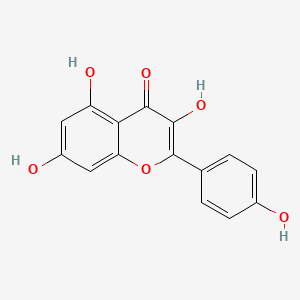D0969 | kaempferol
| Toxicity | Dose | Time | Species | Model | Method | Action | Positive criterion | Reference |
|---|---|---|---|---|---|---|---|---|
| MEMBRANE POTENTIAL | 2.56±3.04 | human | qHTS-HepG2 | MMP assay | decrease | IC50 | 163 | |
| MEMBRANE POTENTIAL | 6.76 | human | HepG2 | MMP assay | decrease | IC50 | 163 | |
| MEMBRANE POTENTIAL | 24.06±8.76 | rat | hepatocytes | MMP assay | decrease | IC50 | 163 | |
| ELECTRON TRANSPORT CHAIN | 55 μM | rat | brain MF0F1-ATPase | decrease | IC50 | 140 | ||
| TRANSPORT OF CALCIUM | 1μM | The HeLa cell clone MM5 expressing mitochondrially targeted mutated aequorin was used for [Ca2+]M measurements. [Ca2+]c measurements were carried out using HeLa cells transiently transfected with the plasmid for cytosolic aequorin. | increase | 234 | ||||
| TRANSPORT OF CALCIUM | 7μM | The HeLa cell clone MM5 expressing mitochondrially targeted mutated aequorin was used for [Ca2+]M measurements. [Ca2+]c measurements were carried out using HeLa cells transiently transfected with the plasmid for cytosolic aequorin. | increase | EC50 | 234 | |||
| ACCUMULATION OF CALCIUM | 10 μmol/L | periodically paced rat ventricular myocytes (VMs) under β-adrenergic stimulation | mitochondrial Ca2+ monitored by mitochondrial-targeted Ca2+ biosensor mtRCamp1h. | 241 | ||||
| HEART-SPECIFIC OXIDATIVE STRESS | 10 μmol/L | rat | ventricular myocytes | redox-sensitive OMM-HyPer and ERroGFP_iE biosensors | 241 | |||
| Target | Dose | Time | Species | Model | Method | Action | Positive criterion | Reference |
|---|---|---|---|---|---|---|---|---|
| ATP synthase | 55 μM | rat | brain MF0F1-ATPase | inhibitor | IC50 | 140 | ||
| mCU (mitochondrial calcium uniporter) | 1μM | The HeLa cell clone MM5 expressing mitochondrially targeted mutated aequorin was used for [Ca2+]M measurements. [Ca2+]c measurements were carried out using HeLa cells transiently transfected with the plasmid for cytosolic aequorin. | activate | 234 | ||||
| mCU (mitochondrial calcium uniporter) | 7μM | The HeLa cell clone MM5 expressing mitochondrially targeted mutated aequorin was used for [Ca2+]M measurements. [Ca2+]c measurements were carried out using HeLa cells transiently transfected with the plasmid for cytosolic aequorin. | activate | EC50 | 234 | |||
| mCU (mitochondrial calcium uniporter) | 10 μmol/L | periodically paced rat ventricular myocytes (VMs) under β-adrenergic stimulation | mitochondrial Ca2+ monitored by mitochondrial-targeted Ca2+ biosensor mtRCamp1h. | 241 | ||||
| Pictogram | Signal | Statements | Precautionary Statement Codes |
|---|---|---|---|
  |
Danger |
Aggregated GHS information provided by 45 companies from 5 notifications to the ECHA C&L Inventory. Each notification may be associated with multiple companies. Reported as not meeting GHS hazard criteria by 1 of 45 companies. For more detailed information, please visit ECHA C&L website Of the 4 notification(s) provided by 44 of 45 companies with hazard statement code(s): H301 (88.64%): Toxic if swallowed [Danger Acute toxicity, oral] H341 (93.18%): Suspected of causing genetic defects [Warning Germ cell mutagenicity] Information may vary between notifications depending on impurities, additives, and other factors. The percentage value in parenthesis indicates the notified classification ratio from companies that provide hazard codes. Only hazard codes with percentage values above 10% are shown. |
P201, P202, P264, P270, P281, P301+P310, P308+P313, P321, P330, P405, and P501; (The corresponding statement to each P-code can be found at the GHS Classification page.) |
| 2-(4-hydroxyphenyl)-3,5,7-tris(oxidanyl)chromen-4-one | 3,4′,5,7-Tetrahydroxyflavone | 3,4',5,7-Tetrahydroxyflavone |
| 3,4',5,7-tetrahydroxy-Flavone (7CI,8CI) | 3,4,5,7-Tetrahydroxyflavone | 3,5,7,4'-Tetrahydroxyflavone |
| 3,5,7-Tetrahydroxyflavone | 3,5,7-Trihydroxy-2-(4-hydroxyphenyl)-4H-1-benzopyran-4-one | 3,5,7-Trihydroxy-2-(4-hydroxyphenyl)-4H-chromen-4-one |
| 3,5,7-Trihydroxy-2-(4-hydroxyphenyl)-4H-chromen-4-one # | 3,5,7-trihydroxy-2-(4-hydroxyphenyl)-1-benzopyran-4-one | 3,5,7-trihydroxy-2-(4-hydroxyphenyl)-4H-1- benzopyran-4-one |
| 3,5,7-trihydroxy-2-(4-hydroxyphenyl)-chromen-4-one | 3,5,7-trihydroxy-2-(4-hydroxyphenyl)chromen-4-one | 4',5,7-trihydroxyflavonol |
| 4H-1-Benzopyran-4-one, 3,5,7-trihydroxy-2-(4-hydroxyphenyl)- | 4H-1-Benzopyran-4-one, 3,5,7-trihydroxy-2-(4-hydroxyphenyl)- (9CI); | 4H-1-Benzopyran-4-one,5,7-trihydroxy-2-(4-hydroxyphenyl)- |
| 4det | 5,4'-Trihydroxyflavonol | 5,7,4'-Trihydroxyflavonol |
| 5-18-05-00251 (Beilstein Handbook Reference) | 520-18-3 | 520K183 |
| 731P2LE49E | A10495 | A828886 |
| A91A6666-86C8-4B33-B3EF-F74CD3CD7F47 | AB0010534 | AB00514046 |
| AC-544 | ACon1_001867 | AI3-36096 |
| AK168074 | AKOS015895240 | BDBM7462 |
| BIDD:ER0134 | BIDD:PXR0073 | BPBio1_001294 |
| BRD-K12807006-001-05-2 | BRD-K12807006-001-10-2 | BRN 0304401 |
| BSPBio_001176 | C-18018 | C.I. 75640 |
| C05903 | CAS-520-18-3 | CC-29746 |
| CCG-202823 | CCRIS 41 | CHEBI: 28499 |
| CHEBI:28499 | CHEMBL150 | CK0011 |
| CS-1273 | Campherol | DB01852 |
| DSSTox_CID_768 | DSSTox_GSID_20768 | DSSTox_RID_75781 |
| DTXSID7020768 | EINECS 208-287-6 | FT-0614420 |
| Flavone, 3,4',5,7-tetrahydroxy- | Flavone, 3,4',5,7-tetrahydroxy- (7CI,8CI) | Flavone,4',5,7-tetrahydroxy- |
| GP7425 | GS-3570 | HMS1571K18 |
| HMS2098K18 | HMS2267I09 | HMS3414C03 |
| HMS3656M03 | HMS3678C03 | HSCI1_000027 |
| HSDB 7703 | HY-14590 | IYRMWMYZSQPJKC-UHFFFAOYSA-N |
| Indigo Yellow | J10449 | K0018 |
| Kaemferol | Kaempferol, 97% | Kaempferol, >=90% (HPLC), powder |
| Kaempferol, >=97.0% (HPLC) | Kaempferol, United States Pharmacopeia (USP) Reference Standard | Kaempferol, analytical standard |
| Kaempferol, primary pharmaceutical reference standard | Kaempferol,(S) | Kaempherol |
| Kampcetin | Kampferol | Kampherol |
| Kempferol | LMPK12110003 | LS-176 |
| MCULE-8965218413 | MEGxp0_001283 | MFCD00016938 |
| MLS000697730 | MLS001055391 | MLS001074884 |
| MLS006010737 | N1719 | NCGC00016480-01 |
| NCGC00016480-02 | NCGC00016480-03 | NCGC00016480-04 |
| NCGC00016480-05 | NCGC00016480-06 | NCGC00016480-07 |
| NCGC00016480-09 | NCGC00091036-01 | NCGC00091036-02 |
| NCGC00164322-01 | NCGC00179275-01 | NCGC00179275-02 |
| NCGC00257464-01 | NCGC00258717-01 | NSC 407289 |
| NSC 656277 | NSC-407289 | NSC-656277 |
| NSC407289 | NSC656277 | Nimbecetin |
| Oprea1_650954 | Pelargidenolon | Pelargidenolon 1497 |
| Pelargidenon | Populnetin | Prestwick0_001098 |
| Prestwick1_001098 | Prestwick2_001098 | Prestwick3_001098 |
| Q-100584 | Q393336 | Rhamnolutein |
| Rhamnolutin | Robigenin | S00111 |
| SBB066091 | SC-17291 | SCHEMBL18817 |
| SMR000112585 | SPBio_003058 | SR-01000765646 |
| SR-01000765646-3 | ST030560 | SW197199-2 |
| SY023424 | Swartziol | TNP00039 |
| TR-018501 | Tox21_201165 | Tox21_303363 |
| Trifolitin | UNII-731P2LE49E | W-2776 |
| W1682 | ZINC3869768 | cid_5280863 |
| kaempferol | s2314 |

